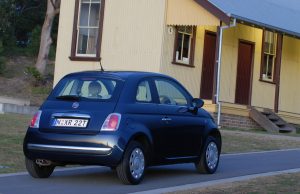Recalls: Fiat 500
Overview
Manufacturers, or importers, issue recalls for defects or faults which have the potential to cause injury. Generally, manufacturers will inform the original buyers if their vehicle is subject to a recall and of the steps required to remedy the defect or fault. Please note that the recalls below (if any) are for Australian-delivered vehicles only. Furthermore, the number of recalls should not be taken as an indication of a model’s reliability or its safety more generally.
Recalls: Fiat 500
- In March 2009, a recall was issued for Fiat 500 vehicles due to the the rear brake shoe holder locating pin to potentially come loose (PRA 2009/10685).
- In August 2010, a recall was issued for Fiat 500 vehicles due to potentially inconsistent inflation of the side airbags due to non-compliant air bag control unit software (PRA 2010/11941).
- In July 2014, a recall was issued for Fiat 500 vehicles due to potential interference of the wiring under the dashboard with the steering column. This could cause the wiring to wear out over time, affecting how the vehicle drives and posing an accident risk to the driver and other road users (PRA 2014/14233).
- In April 2016, a recall was issued for 2014 Fiat 500 and Fiat 500C vehicles because of potential deviation in the heat treatment process of the seatbelt buckle such that the seatbelt anchorage links may not comply with safety standards. If the seatbelt did not function correctly, there was an increased risk of injury to the occupant in the event of a collision (PRA 2016/15320).
Problems and faults: Fiat 500
Overview
This section identifies potential problems, causes and fixes based on the experiences of owners and repairers, online sources and technical service bulletins. This information is provided solely for reference purposes and AustralianCar.Reviews recommends that only properly qualified persons carry out repairs or modifications. Furthermore, the number of items below should not be taken as an indicator of a model’s reliability or the frequency with which they may occur.
To report a problem or fault to the AustralianCar.Reviews team, please use the Contact Us form. Note that AustralianCar.Reviews does not offer advice on automotive problems or disputes; such enquiries will not receive a reply. For vehicles purchased from dealers after 1 January 2011, please see our Australian Consumer Law fact sheet.
Fiat 500 1.2 8v: rocker cover gasket change
For Fiat’s 1.2-litre 8 valve ‘Fire’ engine, the rocker cover gasket is only meant to last two years or 40,000 kilometres before replacement.
On even numbered services, the service procedure recommends checking the mechanical tappet clearance on these engines. As part of this procedure, the rocker cover gasket is to be changed and the cam cover needs to be removed for this to be performed. If having your vehicle serviced, it is suggested that you could put a paint mark on the gasket seal so you will know if it has been replaced.
For further information, please see Fiat Forum: 1.2 8v cam/rocker cover gasket change.
Fiat 500 with DuaLogic: ‘gear unavailable’
For Fiat 500 vehicles with the five-speed ‘DuaLogic’ semi-automatic transmission, the ‘gear unavailable’ message may appear in the instrument cluster while driving or at idle. If this occurred while driving, the driver may be unable to change gear; if the driver slowed to rest, there may be a delay in selecting neutral (‘N’) followed by sudden jerk as it engaged. For these vehicles, it may be necessary to replace the DuaLogic pump which consisted of three components: a pump, accumulator and an actuator.
2014-15 Fiat 500 1.2 (EU6): hesitation when accelerating from rest
For 2014 and 2015 Fiat 500 vehicles that had 1.2-litre petrol engines which complied with Euro 6 (EU6) emissions standards, owners have complained of a lack of power at engine speeds below 3000 rpm which makes it difficult to accelerate from rest, particularly uphill. It is believed that this problem was caused by engine mapping introduced for the EU6 compliant 1.2-litre petrol engine that was available from May 2014.
In BBC’s Watchdog program, a mechanic attributed the difficulty in accelerating to a delay between pressing the accelerator pedal and the engine’s response. In the video below, stunt driver Ben Collins attempts to drive the Fiat 500 up a hill, concluding that there was a lack of power below 3000 rpm and that it was necessary to rev the engine to 5000 rpm and ride the clutch in order to drive up the hill.
In a statement following BBC’s Watchdog programme, Fiat acknowledged that the majority of complaints it had received were for EU6 compliant Fiat 500 1.2 vehicles that did not have electronic stability control (ESC) and that these vehicles had different engine software to those which did have ESC.
In March 2015, Fiat introduced a series of rectification measures to address these problems:
- Replacement of the clutch position sensor;
- An ECU update for idle and emissions controls; and,
- An ESC update (for models which had ESC).
Fiat 500 1.3 MultiJet diesel: timing chain failure
The 1.3 MultiJet 16V diesel engine has a paper insert oil filter which can clog and crumble – this causes the oil feed pipe for the chain tensioner to become blocked which, in turn, causes the timing chain to stretch, become slack and potentially break. The 1.3 MultiJet 16V engine has 32,000 kilometre service intervals and more frequent changes are recommended to prevent this from occurring. If the timing chains are replaced, the crank pulley bolt must be tightened to the required specification or it can come loose, adversely affect the engine’s timing and snap the rockers.
Fiat 500 1.MultiJet Diesel: failed DPF regeneration
For Fiat 500 vehicles with the 1.3 MultiJet diesel engine and diesel particulate filter (DPF), the filter can become clogged with soot such that it needs to be regenerated. To regenerate the DPF, excess fuel is injected to raise the temperature of the exhaust gases sufficiently to burn off the soot. However, this excess diesel fuel can seep into the sump and raise the level of sump oil such that the sump oil enters the engine and causes serious damage.
Fiat 500 1.3 MultiJet Diesel: mass airflow sensor failure
The MAF (mass airflow) sensor – located between the air filter and inlet – is susceptible to failure, causing rough running, a loss of power and difficulty starting the engine when cold.
Fiat 500 1.3 MultiJet diesel: oil cooler failure
For the Fiat 500 1.3 MultiJet Diesel, the oil cooler could fail and leak oil into the coolant system. If this occurred, the cooling system would not work effectively and engine temperatures could increase, posing a risk of further damage. It is recommended that owners regularly check the coolant reservoir in the engine bay for signs of oil.




